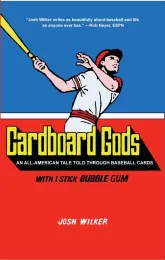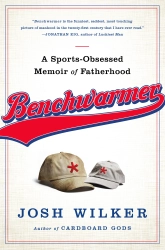I received an advance copy of Baseball Fantography just as I was finishing the recent series on Cardboard Gods that had been inspired by a photo on the Fantography™ website of Padres pitcher Dave Freisleben and Topps photographer Doug McWilliams. I am dipping into the beautiful book slowly, savoring it. My favorite photo so far is one of Lou Brock in a leisure suit shaking hands with a couple 1970s yayos, one of whom is in a cutoff Black Sabbath T-shirt. And then there’s a section that expands on the “making of” photo of McWilliams snapping the baseball card portrait of Freisleben. Many more images from the 1975 Padres photo shoot (including one of Tito Fuentes with his “Tito” headband) surround an essay by none other than Doug McWilliams, the man behind many of the images that, weirdly, joyously, anchor my life. Baseball Fantography would be worth the price of purchase for that section alone, but the whole book is spilling over with colorful images from the beating heart of the game.
The author of Baseball Fantography, Andy Strasberg, was kind enough to answer a few of my questions about the book and about his long and eventful life in baseball.
1. I’m really looking forward to the Baseball Fantography book (due out April 1, 2012). It seems like a book that needs to exist, and one that will help highlight the unique voices of individual fans at a time when the big business of baseball is tending to flatten out and obscure those voices. What was the key moment in the development of the idea for the Fantography site and the book? When did you say to yourself something along the lines of “this idea has to be done, and I have to do it”?
1997 was the year that I came up with the concept and called Marty Appel who agreed immediately that it was good idea. Our plan was to have fans send their originals to a PO box and we would have them copied and then return them. We both agreed that it would not work because people would not risk sending their treasured photographs in the mail for the fear of it getting lost. Then in 2000 I thought that fans with photo could go into Kinko’s and have them scanned and emailed to me . . . but that too was a lot to ask of fans. Then in 2008 I felt that there were enough home scanners and people using digital photographer that they could do it from their home and I was right.
2. I know you’ve spent your whole life around the game, first as a supremely dedicated fan and later as a vice president for the Padres. Some would be tempted to assume that you’ve “seen it all.” In gathering the images for the site and the book, what photo most surprised you, and why?
I LOVE the snapshots of players before they enter the ball park. I have hundreds of snapshots of players walking down the street as far back as the 1940s. I can only imagine how excited a fan was to capture a photo of a player in street clothes walking down the street in Brooklyn on the way to Ebbets Field.
3. I believe that in your work with the Padres from the 1970s to the 1990s [Strasberg was the vice president of marketing for the team], you were involved in many promotional events. What part, if any, did you play in Kurt Bevacqua catching a ball thrown from the top of a building in downtown San Diego? What can you tell us about that immortal day?
I was given credit for the idea but actually adapted the concept from the 1908 Gabby Street Washington Monument event. My favorite part of setting up the event was that I asked permission from our GM Jack McKeon who said he was fine with it as long as Dick Williams our manager approved of it. So I went to Dick and asked him. He said it was OK and then I warned him that Kurt could possibly get hurt and Dick didn’t pause for a second and said, “I know.”
4. Also, when Bevacqua came to the Padres, he had already featured in one of the greatest moments in Topps baseball cards as the 1975 Joe Garagiola/Bazooka Bubble Gum Blowing Champ. Did you ever witness any residue of this feat? I’m praying there are stories of young gunslingers constantly challenging the weary champ to bubble gum blowing duels. Short of that, any other anecdotes about Bevacqua would be greatly appreciated.
I never saw any one challenge Kurt in a Bubble blowing showdown.
One of my favorite “Dirty Kurt” stories happened during the 1984 World Series. We were in Detroit for game three and I was in the dugout just before introductions. Kurt bet me $10 that he would purposely slip coming out of the dugout. I told him he wouldn’t and the bet was on. His name was announced by the stadium PA and he tripped on the top step and then turned around and shouted at me that I owed him ten bucks.
5. I first became aware of the amazing Fantography website when a writer, Greg Hanlon, let me know about a particular photo on the site. It’s the one that you took of Doug McWilliams’ snapping the portrait that would appear on Dave Freisleben’s 1976 card. For someone like me, who has put such importance on the baseball cards of the 1970s, it is an amazing moment, a singular glimpse behind a magical curtain, and I thank you for capturing it. What are your memories of that moment?
I could not use a flash so all of my photos came out dark because of the shadows. I also tried to capture the exact moment that Doug shot his photos and from an off center angle. I knew that I wanted to capture the exact moment a baseball card photo was being born.
6. It seems from looking at the 1976 Padres cards that several photos may have been taken that day. Do you recall whether that was the case, and if so, can you give us some sense of how the photo shoot proceeded that day? Was there a lot of waiting around and/or bored horseplay? How long did McWilliams generally take with each of his subjects?
Doug took perhaps less than 3 minutes with each player but sometimes waited as long as 20 minutes waiting for the next guy. The entire shooting process took hours.
7. What did the players think of the baseball card photo shoots?
Most enjoyed it, others seemed to be somewhat bothered by the distraction and interruption of their spring training routine.
8. I love Doug McWilliams’ work. As someone who obviously also has a knack with baseball photos, what you can tell us about Doug McWilliams as an artist from what you saw that day or from other experiences with him?
Doug is one of the nicest and classiest guys in baseball. He’s kind, low-key and very considerate. We became friends quickly and have remained so after all these years. A baseball writer told me after I got my job with the Padres that even though he knew I was a collector of baseball memorabilia he said that the best thing I will collect will be the friends I make. At the time I thought he was crazy . . . but after 20 plus years he was right and Doug is one of those cherished friendships.
9. In addition to your work in the game and as a baseball historian and author, I believe you are also a passionate collector of baseball memorabilia. What piece from your collection would you be most reluctant to part with, and why?
When I was 17 years old Roger Maris gave me one of his bats in 1965. It was a confirmation from my childhood hero of a promise he made to me earlier that season. At that point it was the greatest day of my life!







You must be logged in to post a comment.